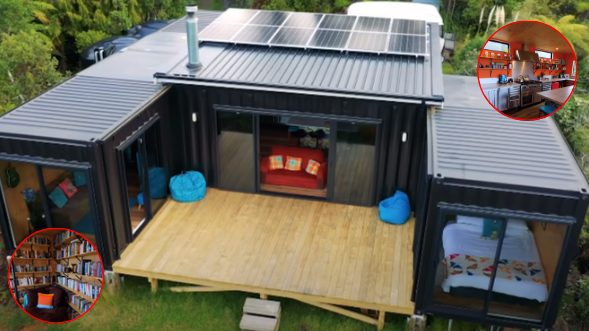In a world where the chaos of urban living can often feel overwhelming, many people dream of escaping to a simpler, more natural lifestyle. Rosie, a visionary homeowner, turned this dream into a reality by creating an extraordinary off-grid shipping container home in the serene forests of Coromandel, New Zealand. Her journey is not just about building a home—it’s about crafting a sustainable sanctuary that reflects her values and aspirations.
The Search for Solitude
Rosie’s story began when she decided to leave the bustling city life of Auckland behind. Selling her home in the city, she embarked on a mission to find a piece of land that resonated with her vision of peace and sustainability. She discovered Mahakadel Forest Estate, a private sanctuary spanning 1,100 acres, comprising 25 lots of lush forest. Rosie’s lot, though the smallest at 23 acres, was a perfect fit. The estate’s QE2 covenant ensures guardianship of the land and its native creatures, aligning perfectly with her values.
“I got out of the car and knew I needed to live here,” Rosie recalls of her first visit to the land. This moment of connection set the stage for the remarkable home she would go on to build.
Building the Dream Home
Rosie’s home is constructed from four 20-foot shipping containers, offering a total living space of 60 square meters. An additional container serves as a utility space, housing a mudroom and the systems that power her off-grid lifestyle.
“I love the industrial look,” Rosie explains, highlighting the durability and adaptability of shipping containers. Her choice was also practical—containers can be expanded vertically or horizontally if she ever decides to grow her home.
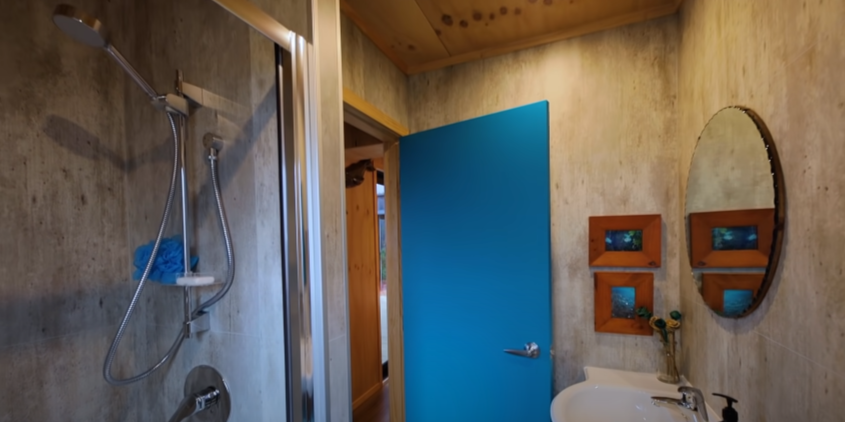
Off-Grid Living at Its Best
Being off-grid was not just a choice for Rosie; it was a dream. Her home operates entirely on solar power, with a 4-kilowatt inverter system supported by 12 solar panels. Two 25,000-liter water tanks ensure a steady supply of water, while a worm composting septic system manages waste sustainably.
“Being off-grid is empowering,” Rosie says. “It’s a safe feeling knowing I’ll always have water and power without bills. If anything happens in the world, I’m okay.”
This autonomy extends to the home’s layout, which maximizes natural light and air circulation. The outdoor spaces are designed to embrace both morning and evening sun, creating an idyllic environment for relaxation and connection with nature.
A Thoughtful Design
Rosie’s home is not just functional—it’s a masterpiece of personal expression. The kitchen, for example, is crafted from tool trolleys purchased on sale, giving the space a unique, high-end industrial aesthetic. At a fraction of the cost of traditional cabinetry, this innovation exemplifies her resourcefulness and creativity.
“I love cooking, and this is the best kitchen I’ve ever had,” Rosie says. The bright orange walls, paired with natural plywood accents, create a vibrant yet cozy atmosphere. “When the sunrise hits the orange walls, the whole room glows—it’s gorgeous.”
The home also features eco-friendly insulation, double-glazed windows, and a compact wood fire that doubles as an oven, ensuring comfort and practicality even in the colder months.
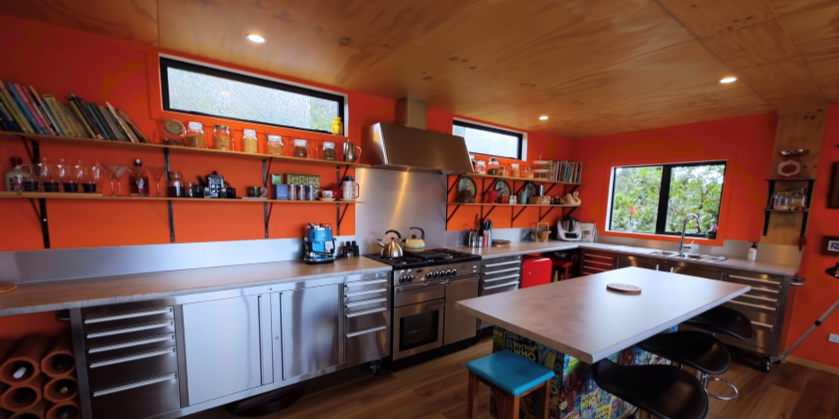
A Personal Library and More
One standout feature of Rosie’s home is her floor-to-ceiling personal library—a collection of books amassed over decades. For Rosie, this library is not just a storage solution but a sanctuary for her love of reading. “It’s one of the few areas of my life where I’m organized,” she jokes.
Her passion for design extends to every corner of the home. From the minimalist yet functional wardrobe to the clever integration of book storage in her bedroom, Rosie has made sure every detail serves a purpose while reflecting her personality.
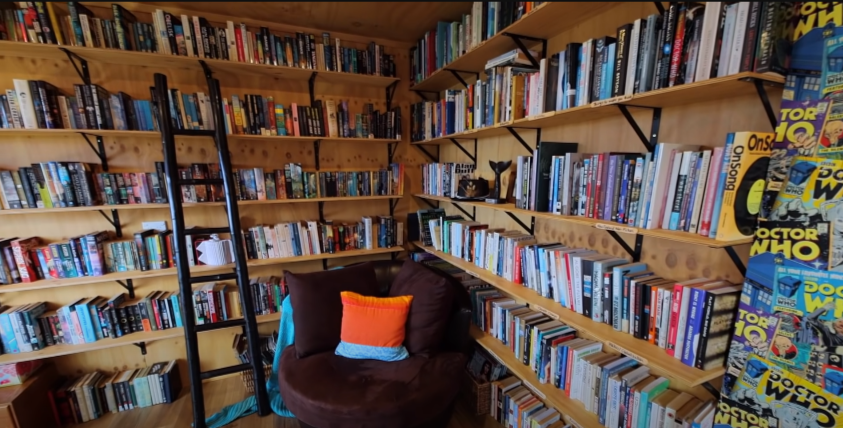
Connection to the Land
Rosie’s connection to her land is deeply spiritual. She named her home “Wahi Tapu,” meaning “sacred space,” to honor the history and significance of the forest. Her daughter, an artist, contributed artwork to the home, adding a layer of familial connection to the space.
The property’s panoramic views, especially at sunrise and sunset, are a daily reminder of why Rosie chose this life. “Waking up to these views and looking at the stars at night—it’s stunning,” she says.
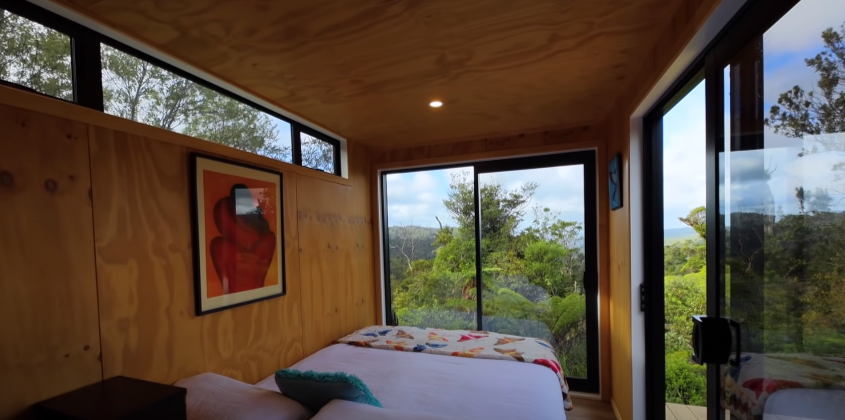
Sustainable Future Planning
Although Rosie doesn’t live in her home full-time yet, she plans to retire there in the future. Her forward-thinking design includes features like an accessible shower and grab rails, ensuring the home will remain functional as she ages.
“I wanted to future-proof the house,” she says, reflecting her background as an occupational therapist. This foresight ensures the home will remain a sanctuary for years to come.
The Cost of a Dream
Building a home like Rosie’s required careful planning and budgeting. With a total cost of around $450,000 NZD, the project was made feasible through the sale of her Auckland property. By comparison to city prices, the investment felt more than worthwhile.
“Designing this house from scratch was a wonderful journey,” Rosie says. “It’s a perfect Rosie house—me all over it.”
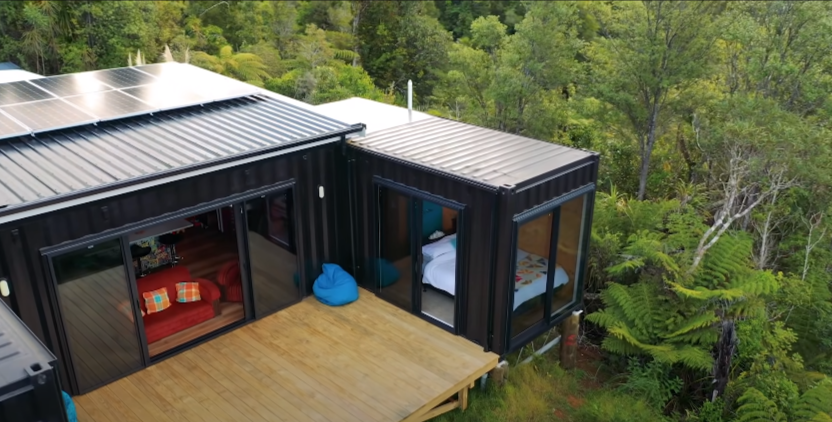
FAQS
1. Why did Rosie decide to build an off-grid home?
Rosie wanted to escape city life in Auckland and embrace a sustainable, self-sufficient lifestyle closer to nature.
2. What is the home made of?
The home is constructed using four 20-foot shipping containers for living spaces and one additional container for utilities.
3. How is the home powered?
The home is powered by a 4-kilowatt solar inverter system with 12 solar panels.
4. What is the water supply system?
Rainwater is collected and stored in two 25,000-liter tanks, providing the home’s water needs.
5. How does the waste system work?
A worm composting septic system processes black water, while grey water is stored separately for safe disposal.
6. Why did Rosie choose shipping containers?
She loved the industrial look, their durability, and the flexibility to expand or modify the design later.
`7. How big is the home?
The living space is 60 square meters, excluding outdoor areas.
8. What makes the location special?
The home is part of Mahakadel Forest Estate, a private sanctuary with 95% native bush conservation.
9. How much did it cost to build the home?
The total cost of the home was approximately $450,000 NZD.
10. Is the home used full-time?
Not yet. Rosie plans to retire there in the future, but she spends as much time as possible at the property.
Conclusion
Rosie’s off-grid shipping container home is more than just a dwelling—it’s a testament to her determination, creativity, and commitment to sustainability. Her story inspires anyone dreaming of escaping the chaos of urban life to embrace a simpler, more harmonious existence with nature.
From its unique design to its thoughtful integration with the land, this home is a shining example of how passion and vision can create a truly extraordinary lifestyle. For Rosie, the trials of building such a home pale in comparison to the joy of sitting on her deck, gazing at the horizon, and knowing she’s exactly where she’s meant to be.
